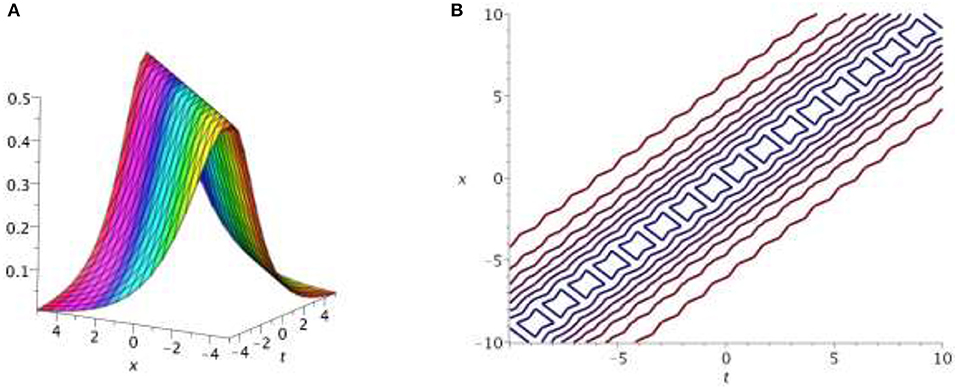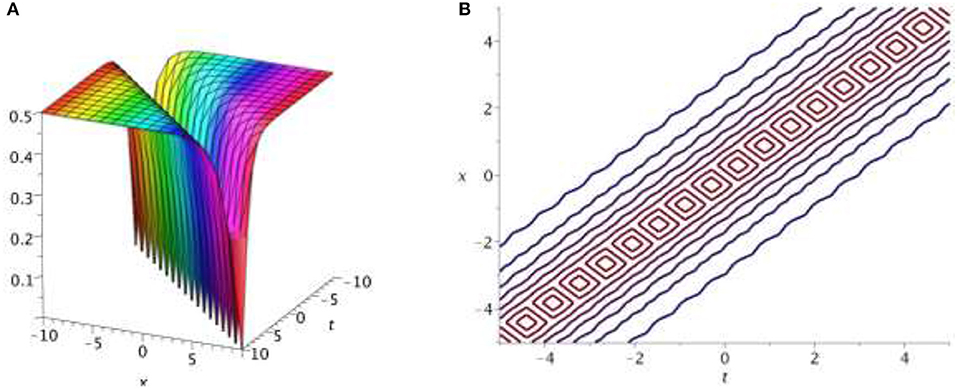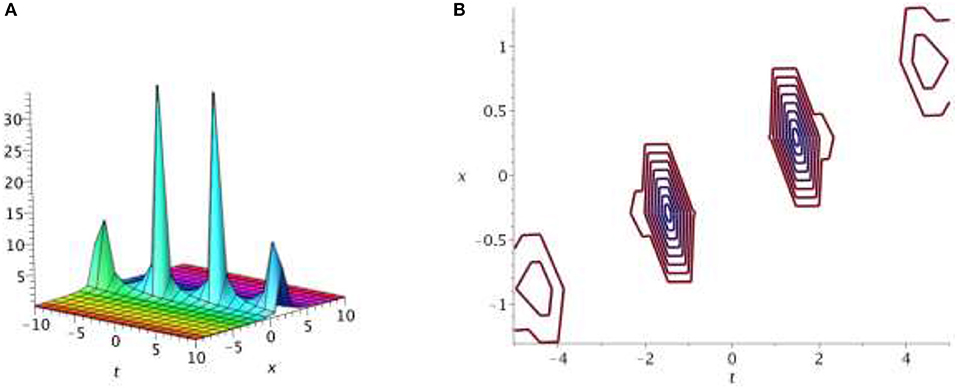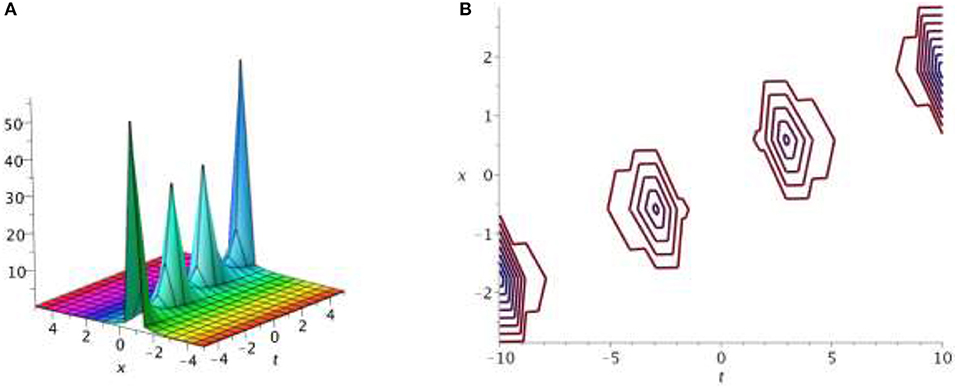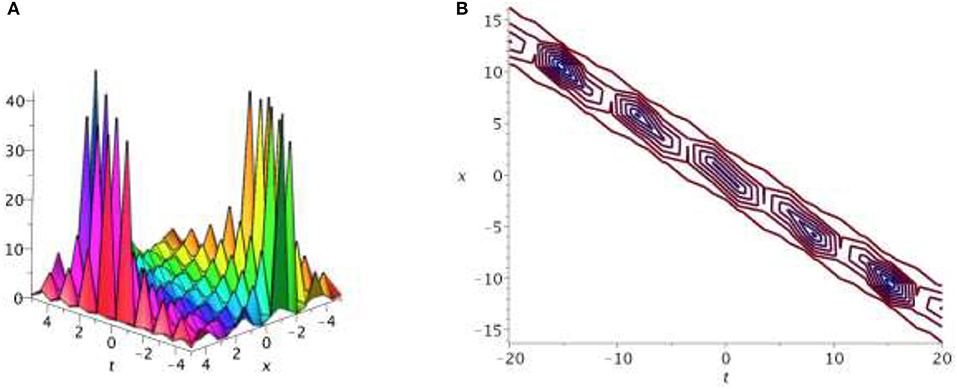- 1Department of Mathematics, Faculty of Sciences, HITEC University, Taxila, Pakistan
- 2Department of Mathematics and Statistics, Hazara University, Mansehra, Pakistan
- 3University of Multan, Multan, Pakistan
- 4Faculty of Mathematics and Statistics, Ton Duc Thang University, Ho Chi Minh City, Vietnam
- 5Center of Excellence for Research in Engineering Materials (CEREM), King Saud University, Al-Riyadh, Saudi Arabia
- 6Electrochemistry and Corrosion Laboratory, Department of Physical Chemistry, National Research Centre, Dokki, Egypt
In this paper, we investigated the non-linear Schrödinger equation (NLS) to extract optical soliton solutions by implementing the extended Sinh–Gordon equation expansion method (ShGEEM). Optical soliton solutions included bright, dark, combined bright-dark, singular soliton combined singular soliton solutions, and singular periodic wave solutions. Our new results have been compared to these in the literature. Also, graphical analysis was presented with 3D and contour graphs to understand the physics of obtained solutions.
Introduction
In recent years, soliton propagation in non-linear optical fiber has become the most extensive topic of research in the field of non-linear sciences. In non-linear optical fiber, the study of the non-linear Schrödinger equation (NLS) plays an important role in order to understand the dynamical behavior of optical soliton. NLS helps to provide exact soliton solutions in non-linear fiber optics. During the last few years, in the study of optical solitons, many new research developments have taken place, which is a great achievement in the field of soliton [1–15]. However, there are a lot of problems that need to be solved.
Many new methods have been developed to tackle complicated problems in a very smooth manner and provide exact soliton solutions of these problems such as the modified simple equation method [16, 17], the extended trial equation method [18, 19], the tan-expansion method [20, 21], and many others.
In this paper, our main focus is the study of NLS [22]. This equation has large physical importance in non-linear optics.
where V(x, t) is a complex function and σ is a constant. It should also be noted that, for σ = 0, Equation (1) reduces to the non-Kerr law non-linearity as
To study Equation (1), we consider the following wave transformation:
where φ(x, t) is the phase component, and k, ϖ, θ, and υ represent the frequency, wave number, phase constant, and velocity of the soliton. By substituting Equation (3) into Equation (1), we obtain the following real and imaginary equations:
Algorithm of Extended ShGEEM
To describe the mechanism of the extended Sinh–Gordon equation method (SGEM) for differential equations, we consider the equation [23]
where Υ = Υ(x, t) and ϱ is a nonzero constant.
Applying the traveling wave transformation Υ(x, t) = Φ(ζ), ζ = λ(x − μt), to Equation (6), we acquire the following form of non-linear ODE:
where Φ = Φ(ζ), λ is a wave number, and μ is the velocity of the traveling wave. By applying the integration procedure, Equation (7) can be found in a simplified form:
where r is the constant of integration. Setting and , into Equation (8) yields
Equation (9) has the following set of solutions, by substituting different values for given parameters θ and r.
Set I:
If we substitute r = 0, θ = 1 in Equation (9), we obtain
Simplifying Equation (10), we acquire the following solutions:
and
where
Set II:
If we substitute r = 1, θ = 1 in Equation (9), we have the following equation:
After simplification in Equation (13), we have the following solutions:
and
To obtain the different wave solutions of non-linear partial differential equations (NPDEs), we consider the equation in the following form:
Step I: By using wave transformation Υ(x, t) = Φ(ζ), ζ = λ(x − μt), we first transform Equation (16) into the following NODE:
Step II: We suppose that Equation (17) has a new ansatz solution in the following form:
where are constants to be determined later. The value of can be determined by balancing the highest order dispersive term with the non-linear term in Equation (17).
Step III: We substitute Equation (18) for the fixed value of in Equation (17) to obtain a polynomial form of equation in v′f sinhg (v) coshι (v), (f = 0, 1 and g, ι = 0, 1, 2……). We get the system of algebraic equations by equating the coefficients of v′f sinhg (v) coshι (v) to be all zero. We extract the values of coefficients by solving the system of algebraic equations with the help of MAPLE 2016.
Step IV: Substituting the values of in Equations (19)–(22), we obtain the following wave solutions to the non-linear Equation (16):
and
Application of Extended ShGEEM to Equation (1)
In this section, Extended ShGEEM [24–29] is implemented to Equation (1).
Considering a homogeneous balance between Φ″ and Φ3 in Equation (4) yields N = 1. And setting the value of N in Equations (18)–(22), we obtain
Substituting Equation (23) together with its derivatives in Equation (4), we get a polynomial equation in v′f sinhg (v) coshι (v), (f = 0, 1 and g, ι = 0, 1, 2……). Using some hyperbolic identities, we acquire a system of algebraic equations by setting the coefficients of v′f sinhg (v) coshι (v) equal to zero. After simplifying the system of equations, we obtain the values of with the help of Maple 16. Subsisting all the values of in any of Equations (24)–(27), we found numerous different types of soliton solutions of Equation (1).
Result I:
Result II:
Result III:
Result IV:
Result V:
Result VI:
Result VII:
Result VIII:
Substituting the values of the above given results in Equations (24)–(27), we get the following solutions.
Case I: Bright Optical Solitons
Substituting the values of the parameters given in Results II and IV into Equation (24):
where (k2 − 2σ2 − ϖ) > 0, for valid solutions.
Case II: Dark Optical Solitons
Substituting the values of the parameters given in Results III and V into Equation (24):
where (−2k2 + 4σ2 + 2ϖ) > 0, for valid solutions.
Case III: Combined Dark-Bright Optical Soliton Solutions
Using the values of the parameters given in Results I and VI into Equation (24):
where (2ϖ − 2k2 + 4σ2) > 0, for valid solutions.
Case IV: Singular Soliton Solutions
Using the values of the parameters given in Results II, III, IV, and V into Equation (25):
where (k2 − 2σ2 − ϖ) > 0, for valid solutions.
where (2ϖ − 2k2 + 4σ2) > 0, for valid solutions.
Case V: Combined Singular Solitons
Substituting the values of the parameters given in Results I and VI into Equation (25):
where (−2k2 + 4σ2 + 2ϖ) > 0, for valid solutions.
Case VI: Singular Periodic Wave Solitons
Substituting the values of the parameters given in Result VII into Equations (26), (27):
where (2k2 − 4σ2 − 2ϖ) > 0, for valid solutions.
Substituting the values of the parameters given in Result VIII into Equations (26), (27):
where (2k2 − 4σ2− 2ϖ) > 0, for valid solutions.
Graphs and Discussions
In this section, we presented some of our obtained solutions in the following figures.
Solutions V1, V2 of Equation (1) depict the bright optical soliton solutions. Figure 1 represents the 3D surface of the bright soliton solution of Equation (36) with a contour plot for given parametric values ρ = 0.5, θ = 0.5, σ = 0.5, k = 0.5.
Solutions V3, V4 of Equation (1) show the dark optical soliton solutions. Figure 2 represents the 3D surface of the dark optical soliton solution of Equation (38) with a contour plot for given parametric values ρ = 0.5, θ = 0.5, σ = 0.5, k = 0.5.
Figures 3, 4 represent the singular and combined singular soliton solutions of Equation (1), obtained from solutions of V8 and V12[Equations (38), (47)] for ρ = 0.065, θ = 1, σ = 0.09, k = 0.095 and ϖ = 0.05, θ = 5, σ = 0.05, k = 0.09.
Solutions V13, V14, V15, V16 of Equation (1) represent the singular periodic wave solutions. Figure 5 illustrates the 3D surface of the singular periodic wave solution of Equation (50) with a contour plot for given parametric values ρ = 2.5, θ = 0.2, σ = 0.2, k = 7.5. For convenience, some other figures are not reported.
Comparisons
In Cheemaa and Younis [22], Nadia Cheema and Muhammad Younis investigated the traveling wave solutions of NLSE by applying the extended Fan sub-equation method. The obtained solutions V3, V4, V8, V10, V11, V12, V15, V16 in this paper are equivalent to the solutions q1, q2, q6, q15, q16. found in Cheemaa and Younis [22] for non-linear Schrödinger's equation. The extended Sinh–Gordon equation expansion method provides a large variety of optical soliton solutions [24–29]. By means of the extended Sinh–Gordon equation expansion method, we found some new more generalized exact solutions. Therefore, these new exact solutions are not reported before for this equation in the literature.
Conclusions
We have implemented the extended Sinh–Gordon equation expansion method to solve the non-linear Schrodinger equation for exact optical soliton solutions. The types of solutions we reported include singular periodic wave solutions, bright, dark, combined bright-dark, singular, and combined singular soliton solutions. The non-linear Schrodinger equation is one of the very major equations arising in the field of optic fibers. Its new solutions are expected to help engineers and scientists working in the field. It is worth mentioning that the solutions obtained by us are more generalized. That is, we have recovered not only many already existing solutions but also many unreported solutions. These new solutions are expected to help scientists working in the fields of optic fiber to understand the phenomenon governed by the non-linear Schrodinger equation. All the solutions have been verified for their exactness. Wherever the reported solutions have been recovered, they have been compared with their counterparts in the literature.
Data Availability Statement
The datasets generated for this study are available on request to the corresponding author.
Author Contributions
The formulation of the problem was done by UK and AI. Non-dimensionalization of the nanofluid models by using invertible transformations done by NA. Mathematical analysis and the graphical results plotted and discussed by SM-D and IK. E-SS revised the whole manuscript and checked the typo mistakes.
Conflict of Interest
The authors declare that the research was conducted in the absence of any commercial or financial relationships that could be construed as a potential conflict of interest.
Acknowledgments
Researchers Supporting Project number (RSP-2019/33), King Saud University, Riyadh, Saudi Arabia.
References
1. Khalique CM, Mhlanga IE. Travelling waves and conservation laws of a. (2 + 1)-dimensional coupling system with Korteweg-de Vries equation. Appl Math Nonlinear Sci. (2018) 3:241–54. doi: 10.21042/AMNS.2018.1.00018
2. Biswas A, Yildirim Y, Yasar E, Triki H, Alshomrani AS, Ullah MZ, et al. Optical soliton perturbation with Gerdjikov–Ivanov equation by modified simple equation method. Optik. (2018) 157:1235–40. doi: 10.1016/j.ijleo.2017.12.101
3. Eskitaşçioglu EI, Aktaş MB, Baskonus HM. New complex and hyperbolic forms for Ablowitz–Kaup–Newell–Segur wave equation with fourth order. Appl Math Nonlinear Sci. (2019) 4:93–100. doi: 10.2478/AMNS.2019.1.00010
4. Mathobo M, Atangana A. Analysis of exact groundwater model within a confined aquifer: new proposed model beyond the Theis equation. Eur Phys J Plus. (2018) 133:415. doi: 10.1140/epjp/i2018-12205-9
5. Inc M, Aliyu AI, Yusuf A, Baleanu D. Optical solitons for biswas-milovic model in nonlinear optics by sine-gordon equation method. Optik. (2018) 157:267–74. doi: 10.1016/j.ijleo.2017.11.061
6. Biswas A, Yildirim Y, Yasar E, Triki H, Alshomrani AS, Ullah MZ, et al. Optical soliton perturbation for complex Ginzburg–Landau equation with modified simple equation method. Optik. (2018) 158:399–415. doi: 10.1016/j.ijleo.2017.12.131
7. Biswas A, Yildirim Y, Yasar E, Zhou Q, Moshokoa SP, Belic M. Optical solitons for Lakshmanan–Porsezian–Daniel model by modified simple equation method. Optik. (2018) 160:24–32. doi: 10.1016/j.ijleo.2018.01.100
8. Biswas A, Yildirim Y, Yasar E, Triki H, Alshomrani AS, Ullah MZ, Zhou Q, Moshokoa SP, Belic M Optical soliton perturbation with full nonlinearity for Kundu–Eckhaus equation by modified simple equation method. Optik. (2018) 157:1376–80. doi: 10.1016/j.ijleo.2017.12.108
9. Biswas A, Yildirim Y, Yasar E, Zhou Q, Moshokoa SP, Belic M. Optical soliton perturbation with resonant nonlinear schrödinger's equation having full nonlinearity by modified simple equation method. Optik. (2018) 160:33–43. doi: 10.1016/j.ijleo.2018.01.098
10. Tariq KU, Seadawy AR. Optical soliton solutions of higher order nonlinear Schrödinger equation in monomode fibers and its applications. Optik. (2018) 154:785–98. doi: 10.1016/j.ijleo.2017.10.063
11. Jawad AJM, Abu-AlShaeer MJ, Biswas A, Zhou Q, Moshokoa S, Belic M. Optical solitons to Lakshmanan-Porsezian-Daniel model for three nonlinear forms. Optik. (2018) 160:197–202. doi: 10.1016/j.ijleo.2018.01.121
12. Jawad AJM, Abu-AlShaeer MJ, Majid FB, Biswas A, Zhou Q, Belic M. Optical soliton perturbation with exotic non-Kerr law nonlinearities. Optik. (2018) 158:1370–9. doi: 10.1016/j.ijleo.2017.12.184
13. Bulut H, Sulaiman TA, Baskonus HM, Aktürk T. On the bright and singular optical solitons to the (2 + 1)-dimensional NLS and the Hirota equations. Opt Quantum Electron. (2018) 50:134. doi: 10.1007/s11082-018-1411-6
14. Baskonus HM, Bulut H, Atangana A. On the complex and hyperbolic structures of the longitudinal wave equation in a magneto-electro-elastic circular rod. Smart Mater Struct. (2016) 25:1–8. doi: 10.1088/0964-1726/25/3/035022
15. Amkadni M, Azzouzi A, Hammouch Z On the exact solutions of laminar MHD flow over a stretching flat plate. Commun Nonlinear Sci. (2008) 13:359–68. doi: 10.1016/j.cnsns.2006.04.002
16. Arnous AH, Ullah MZ, Asma M, Moshokoa SP, Zhou Q, Mirzazadeh M, et al. Dark and singular dispersive optical solitons of Schrödinger–Hirota equation by modified simple equation method. Optik. (2017) 136:445–50. doi: 10.1016/j.ijleo.2017.02.051
17. El-Borai MM, El-Owaidy HM, Ahmed HM, Arnous AH, Moshokoa S, Biswas A, et al. Dark and singular optical solitons with spatio-temporal dispersion using modified simple equation method. Optik. (2017) 130:324–31. doi: 10.1016/j.ijleo.2016.10.105
18. Biswas A, Ekici M, Sonmezoglu A, Triki H, Zhou Q, Moshokoa SP, et al. Dispersive optical solitons with differential group delay by extended trial equation method. Optik. (2018) 158:790–98. doi: 10.1016/j.ijleo.2017.12.193
19. Foroutan M, Zamanpour I, Manafian J. Applications of IBSOM and ETEM for solving the nonlinear chains of atoms with long-range interactions. Eur Phys J Plus. (2017) 132:421. doi: 10.1140/epjp/i2017-11681-7
20. Manafian J, Lakestani M. Abundant soliton solutions for the Kundu–Eckhaus equation via tan[φ(ξ)]-expansion method. Optik. (2016) 127:5543–51. doi: 10.1016/j.ijleo.2016.03.041
21. Ahmed N, Irshad A, Mohyud-Din ST, Khan U. Exact solutions of perturbed nonlinear schrödinger's equation with kerr law nonlinearity by improved tan(2) -expansion method. Opt Quantum Electron. (2018) 50:1–27. doi: 10.1007/s11082-017-1314-y
22. Cheemaa N, Younis M. New and more general traveling wave solutions for nonlinear schrödinger equation. Waves Random and Complex Media. (2016) 26:30–41. doi: 10.1080/17455030.2015.1099761
23. Yan Z. A sinh-Gordon equation expansion method to construct doubly periodic solutions for nonlinear differential equations. Chaos Solitons Fractals. (2003) 16:291–7. doi: 10.1016/S0960-0779(02)00321-1
24. Cattani C, Sulaiman TA, Baskonus HM, Bulut H. Solitons in an inhomogeneous Murnaghan's rod. Eur Phys J Plus. (2018) 133:228. doi: 10.1140/epjp/i2018-12085-y
25. Baskonus HM, Sulaiman TA, Bulut H. On the new wave behavior to the Klein–Gordon–Zakharov equations in plasma physics. Indian J Phys. (2019) 93:393–9. doi: 10.1007/s12648-018-1262-9
26. Cattani C, Sulaiman TA, Baskonus HM, Bulut H. On the soliton solutions to the Nizhnik-Novikov-Veselov and the Drinfel'd-Sokolov systems. Opt Quantum Electron. (2018) 50:138. doi: 10.1007/s11082-018-1406-3
27. Bulut H, Sulaiman TA, Baskonus HM. Dark, bright optical and other solitons with conformable space-time fractional second-order spatiotemporal dispersion. Optik. (2018) 163:1–7. doi: 10.1016/j.ijleo.2018.02.086
28. Bulut H, Sulaiman TA, Baskonus HM, Rezazadeh H, Eslami M, Mirzazadeh M. Optical solitons and other solutions to the conformable space–time fractional Fokas–Lenells equation. Optik. (2018) 172:20–7. doi: 10.1016/j.ijleo.2018.06.108
Keywords: extended Sinh-Gordon equation expansion method (ShGEEM), optical soliton, non-linear Schrödinger equation, exact solutions, singular soliton solution
Citation: Irshad A, Ahmed N, Khan U, Mohyud-Din ST, Khan I and Sherif E-SM (2020) Optical Solutions of Schrödinger Equation Using Extended Sinh–Gordon Equation Expansion Method. Front. Phys. 8:73. doi: 10.3389/fphy.2020.00073
Received: 04 October 2019; Accepted: 03 March 2020;
Published: 07 May 2020.
Edited by:
Xiao-Jun Yang, China University of Mining and Technology, ChinaReviewed by:
Haci Mehmet Baskonus, Harran University, TurkeyCarlo Cattani, University of Tuscia, Italy
Copyright © 2020 Irshad, Ahmed, Khan, Mohyud-Din, Khan and Sherif. This is an open-access article distributed under the terms of the Creative Commons Attribution License (CC BY). The use, distribution or reproduction in other forums is permitted, provided the original author(s) and the copyright owner(s) are credited and that the original publication in this journal is cited, in accordance with accepted academic practice. No use, distribution or reproduction is permitted which does not comply with these terms.
*Correspondence: Ilyas Khan, aWx5YXNraGFuQHRkdHUuZWR1LnZu
†These authors have contributed equally to this work
 Amna Irshad
Amna Irshad Naveed Ahmed1†
Naveed Ahmed1† Umar Khan
Umar Khan Syed Tauseef Mohyud-Din
Syed Tauseef Mohyud-Din